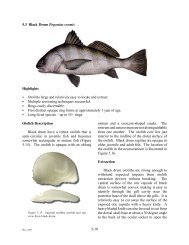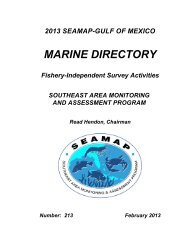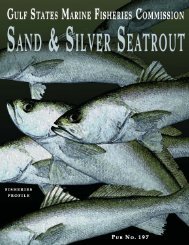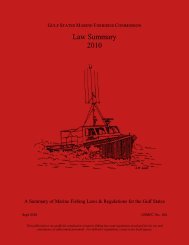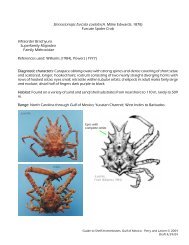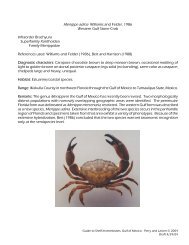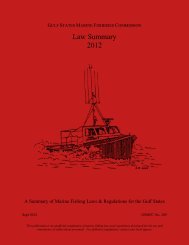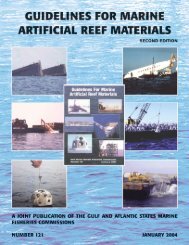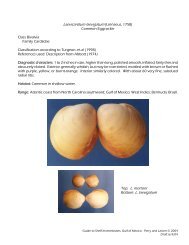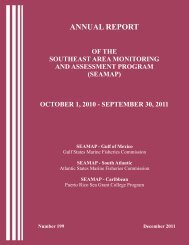Basic Commercial Fishing Regulations - Gulf States Marine ...
Basic Commercial Fishing Regulations - Gulf States Marine ...
Basic Commercial Fishing Regulations - Gulf States Marine ...
Create successful ePaper yourself
Turn your PDF publications into a flip-book with our unique Google optimized e-Paper software.
Boating Information<br />
Voluntary <strong>Gulf</strong> of Mexico <strong>Marine</strong><br />
Communications Protocol<br />
The voluntary <strong>Gulf</strong> of Mexico (GOM) communications<br />
protocol is an agreed communications format that identifies<br />
methods of notification, recommended frequencies and generally<br />
accepted two-way marine VHF radio protocols. It is for use<br />
in GOM Outer Continental Shelf areas and State Territorial<br />
Waters adjacent to Texas, Louisiana, Mississippi and Alabama.<br />
The objective is to provide a common voluntary marine<br />
communications protocol for GOM resource users to use in<br />
alerting parties that will be interacting in the same general area.<br />
This protocol will provide a common communication format for<br />
notification and feedback between offshore platform and rig<br />
operators and others in responding to the safety needs of all<br />
GOM resources users.<br />
Any vessel operator (commercial, for hire (charter/headboat),<br />
recreational fishermen, sport divers and oil and gas contractors<br />
and operators) proposing to approach either fixed or<br />
floating drilling, production and support facilities or oil and gas<br />
transportation infrastructure should utilize the GOM communications<br />
protocol.<br />
PROTOCOL<br />
Any vessel approaching either a fixed or floating offshore<br />
facility with the intent of tying to or remaining around (within<br />
1,500 feet of) that facility for any purpose, should contact as far<br />
in advance as practical that specific facility using a marine VHF<br />
radio on Channel No. 16. All offshore facilities are identified<br />
by signage that identifies the Area, Block, Platform and<br />
Operator.<br />
This protocol helps GOM offshore facility operators identify<br />
vessels approaching or mooring and gives shared resource<br />
users a common communication tool. If vessels fail to establish<br />
communications, a facility operator is faced with the task of<br />
evaluating the vessel's intent. Communications will help operators<br />
make a judgment on the activity and help access if the vessel<br />
poises a threat to the people or facility.<br />
Potential Hazards To Fishermen When<br />
<strong>Fishing</strong> Around Offshore Oil and Gas<br />
Production Platforms<br />
Most offshore fishermen target oil and gas production platforms<br />
as their fishing location of choice. Petroleum platforms,<br />
commonly referred to as “rigs,” provide recreation for fishermen<br />
and scuba divers because they act as artificial reefs, attracting<br />
and establishing aquatic communities, including highly<br />
sought food and sport fishes. Also, offshore facilities serve as<br />
navigation points for small marine craft. Manned facilities can<br />
also provide a haven for small craft operators forced to abandon<br />
their vessels during storms or following accidents.<br />
Generally this interaction between fishermen and offshore<br />
platform personnel takes place without incident. However,<br />
periodically, a fisherman or scuba diver may be asked by platform<br />
personnel to move to another location. This request is<br />
generally made when certain potentially dangerous activities<br />
are taking place onboard the platform and is made for the safety<br />
of both platform personnel and the fisherman.<br />
Some of these potential hazards to fishermen occur when<br />
construction or maintenance activities are underway. These<br />
activities frequently require use of marine support vessels that<br />
limit access to the facility and require frequent movement and<br />
the possibility for entanglement in anchor lines or mooring<br />
hardware exists. Platform cranes making lifts can expose vessels<br />
and personnel to dropped objects, and overhead work, such<br />
as blasting, welding and burning or painting, can also potentially<br />
expose people and equipment to falling debris and equipment.<br />
These activity types are easy to see and the request to<br />
move is easily understood.<br />
Some activities taking place on offshore platforms that may<br />
also be dangerous are not as easily seen, and therefore, a request<br />
to move may be misunderstood. Activities such as well perforating,<br />
poisonous gas releases (red flashing light) or emergency<br />
shut downs that may require significant venting or flaring may<br />
not be visible from the sea surface. Perforating activities require<br />
elimination of radio transmissions to help prevent an inadvertent<br />
triggering of the explosive charges. Gas releases, some of<br />
which may be poisonous (red flashing light), have the potential<br />
to drift to the water surface and envelop a vessel, where an open<br />
flame or spark could set off the gas.<br />
Therefore, if asked by platform personnel to move to<br />
another structure, please understand the request is made for<br />
your safety, the safety of the personnel on board the platform<br />
and the safety of the facilities. Please observe common courtesy<br />
and move to another location.<br />
Example<br />
Contact Request: “Eugene Island 313 “A” Platform, this is M/V<br />
Duck, M/V Duck, on Channel 16”<br />
Response: “Eugene Island 313 “A” back to M/V Duck. Switch to<br />
Channel No. ______.”<br />
Follow Up on New Channel: “M/V Duck back; we are 5 miles<br />
out and in route to your location for ______ (offloading, fishing,<br />
diving, bird watching, etc) and request assistance in determining<br />
your current facility status.”<br />
Recognition: “Eugene Island 313 “A” back; we have no current<br />
marine traffic or hazardous operations but expect a supply boat<br />
later today.” If the facility was planning operations that might<br />
preclude safe positioning of marine craft or if potentially hazardous<br />
lifting or well work is scheduled, the operator would so<br />
inform the vessel.<br />
Notification: “M/V Duck back; we are a 25 foot sport fisherman<br />
out of Cocodrie with a total of five people on board and will<br />
approach your location at 0900 hours and estimate our stay at<br />
three hours.”<br />
The approaching vessel has established contact, identified its<br />
intent to approach or moor, its purpose, and estimated its time of<br />
arrival and time at location. The operator is now alerted to the fact<br />
that the vessel is approaching with the intent of being in the area<br />
and can validate actual activities by visually observing the vessel<br />
and its crew.<br />
38<br />
136




